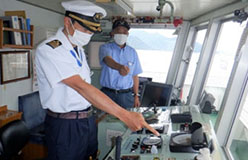To our customers:
In the corona disaster that has not easily subsided, our company has been affected by the corona disaster, the number of users has been sluggish, and management is in a very difficult situation, but we put ” We place the highest priority on safe ferry operations,” at the top of our corporate philosophy, as in the past, we have enhanced our efforts to provide customers with ” safety ” and ” security ” transportation services.
This report is published according to the Marine Transportation Act, in order for us to review our own measures to ensure transportation safety and the safety-related realities of our operations, as well as to facilitate public understanding about our safety efforts.
The report shows the current condition of ferry transportation safety and our safety measures, with the aim of assuring a high level of safety required for public transportation by raising safety awareness among our personnel and improving our safety measures. We hope that you will read this report and appreciate your opinions and advice.
Yasuhiro Oono
President & Representative Director
JR West Miyajima Ferry Co., Ltd.
1. Basic safety principle
To provide customers with safe and secure transportation service, all of us, at JR West Miyajima Ferry, led by the company’s president, unite to promote our “Safety first” measures.
3. Key safety measures
Below are our key safety measures.
(1) Practice of “Essential perspectives in achieving safety ” and Instilling an awareness of safety as the top priority
- Practice of initiatives to be aware of ” Essential perspectives in achieving safety “(formulated by JR West Japan) in daily work
- “When safety cannot be confirmed, ‘stop the train without hesitation’ or ‘stop the work without hesitation.’” We practice the ship version
instructions, reporting, communication, and consultation)
(2) Enhancement of organizational safety management
- Steadily implement the PDCA cycle through quarterly retrospectives based on “safety improvement initiatives” and the implementation of management reviews.
- Utilizing the “Safety Management Guide for Site Managers” formulated by JR West Japan and the “JR West Miyajima Ferry Safety Management Book”, we will clarify weaknesses and work steadily to reinforce them.
- Utilizing the “Guide to Analysis and Formulation of Countermeasures,” we extract (report, provide) and analyze risks related to ship operation (including those that are not directly linked to safety) through m-SHELL analysis, and provide countermeasures and feedback on them. (Shift work, response when there are many customers, etc.)
- Planned risk assessment in response to new business developments (direct management of pier operations, introduction of newly entered vessels, and visitation tax)
(3) Implementation of safety think-and-act by each individual
- Full implementation of pointing and calling and basic actions (clear voice that can be heard by both parties, in order to check the locking status of the bridge and to instruct the seafarers, the operation staff boards the ferry once a day, comprehensive inspection of many customers during the GW, summer, and year-end and New Year holidays, and implementation of counter-terrorism)
- Practical understanding of the human factor (HF) and instillation of risk-based thinking.
- Introduction of the “Human Error Non-Disciplinary System” as a foundation for employees who “actively think, learn, adopt, and try” and organizational building
- Continued implementation of safety lectures in the accident material exhibition room at Hiroshima Branch
(4) Enhancement of ship operation systems that maintain safety
- Improving the efficiency of familiar tasks (mechanization of manual work: utilization of digital equipment)
- Thorough measures to prevent infection of customers and employees based on the with-corona and after-corona
- The captain, chief engineer and shoreside personnel practice “confirmation⇔ but thank you for confirmation” in every situation
- Enhancement of quarterly training
- By reading through the regulations, seafarers and shoreside personnel on the pier understand the regulations and foster mutual trust
- Enhancement of planned repairs based on the history of repairs that occurred and implementation of brush-up plans
4. Safety goals
- Zero maritime accidents, zero accidents causing death or injury to passengers , zero on-the job accidents resulting in employees being absent from work
- Raising employees’ awareness of safety (80% of positive responses in safety questionnaires)
- 25% reduction in the number of ship troubles
5. Ferry inspection
To maintain and enhance safety, we perform ferry inspections in a planned way, in compliance with applicable laws and ordinances.
[Plan for FY2021]
| Nanaura Maru |
Periodic inspection (uncoupling the body and engine) |
| Miyajima Maru |
Interim inspection (uncoupling the body and engine) |
| Misen Maru |
Interim inspection (uncoupling the body and engine) |
6. Major measures implemented in FY2021
- Sharing information through the safety promotion meeting at the JR West Hiroshima Branch
- Establish rescue boat operation standards and revise relevant manuals in preparation for operation of a rescue boat
- Having the staff board ferries for OJT
- Conduct on-site drills including emergency maneuvering drills
- Collect data on phenomena of concern, implement measures based on risk assessments, and give feedback
- Eliminate problems at the large pier in preparation for operation of the Miyajimaguchi Terminal
[Occurrence of accidents, etc.]
- No maritime accidents that cause inconvenience to customers in FY2021 as well
- No accidents causing death or injury to passengers occurred in FY2021 as well
- No on-the-job accidents resulting in employees being absent from work occurred in FY2021 as well
7. Contact address
If you have any comments on the Safety Report, or on our safety measures, feel free to contact us.
Operation Department, JR West Miyajima Ferry Co., Ltd.
1-11-5 Miyajima-guchi, Hatsukaichi City, Hiroshima Prefecture
Tel: +81 (0)829-56-2045 (nine am to noon, one pm to five pm)
FAX: +81 (0)829-56-2049

